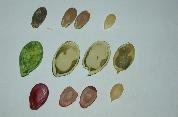Online Encyclopedia
Melon
This article is about the fruits called melons. For other melons, see melon (disambiguation).
A melon (Cucumis melo L .; Muskmelon; Family Cucurbitaceae) is the fruit and plant of a typically vine-like (climber and trailer) herb that was first cultivated more than 4000 years ago (~ 2000 BC) in Persia and Africa. This flowering plant bears an accessory fruit of a type that botanists call a false berry. Many different melon cultivars have been produced, perhaps the most popular or well-known being cantaloupe and honeydew.
The watermelon, also a cucurbit, is classified in the Genus Citrullus.
The subspecies Cucumis melo melo includes numerous interfertile cultivar groups (sometimes as varieties) classified as follows:
- Cantalupensis Group includes the true cantaloupe with skin that is rough and warty, not netted. Also called the European cantaloupe. This melon is not cultivated in North America. Listed sometimes as Cucumis melo cantalupensis.
- Chito Group is the Garden lemon. Also known as the chate of Egypt, Mango melon, Lemon melon, Orange melon, Apple melon, or Vine peach. Referred to sometimes as Cucumis melo melo chito.
- Conomon Group is the oriental pickling melon; it is also known as the Sweet melon, Chekiang melon, or Chinese white cucumber.
- Dudaim Group is the Apple melon (although see Chito group above); it is also known as the Fragrant melon, Pocket melon, Queen Anne's pocket melon, Vine pomegranate, Plum granny, and Dudaim melon. Listed sometimes within Cucumis melo melo var. chito.
- Flexuosus Group is the Armenian cucumber; also known as the Snake melon, Serpent cucumber, Snake cucumber, Serpent melon, or Oriental cucumber.
- Inodorus Group includes Honeydew, Crenshaw, Casaba, Winter melon, American melon, Fragrant melon, or Oriental sweet melon. These have smooth rinds and do not have a musky odor. It is the third most popular type of melon, after the watermelon and cantaloupe. Honeydew has a smooth, white rind and sweet green flesh. When eaten, the texture is similar to a reticulated cantaloupe, but the flavor more subtle and sweeter. Classified sometimes as Cucumis melo inodorus.
- Makuwa Group is the Japanese cantaloupe.
- Reticulatus Group includes Muskmelon, Netted melon, and Cantaloupe (US) of commerce, although this is not the true cantaloupe (see first listing above). Other common names are Nutmeg melon, American cantaloupe, False cantaloupe, and Persian melon. These are the most popular melons cultivated in commerce. Classified as Cucumis melo melo var. cantalupensis by some authors. This group includes the recently rediscovered Montreal melon.
The culture of honeydew and cantaloupe requires a good deal of readily available water for irrigation, and long, hot summers. These melons are susceptible to fungal infections by fusarium and verticillium wilts, as well as a bacterial wilt transmitted by the cucumber beetle .
Various kinds of melon seeds are edible, and are sold as snacks in shops, by names as kwaci and kwatji. For this purpose, they are dried and often salted.
References and external links
- Mabberley, D.J. 1987. The Plant Book. A portable dictionary of the higher plants. Cambridge University Press, Cambridge. 706 pp. ISBN 0521340608.
- Magness, J.R., G.M. Markle, C.C. Compton. 1971. Food and feed crops of the United States. Interregional Research Project IR-4, IR Bul. 1 (Bul. 828 New Jersey Agr. Expt. Sta.).
- Cucumis melo L. – Purdue University, Center for New Crops & Plant Products.
- Sorting Cucumis names – Multilingual multiscript plant name database

